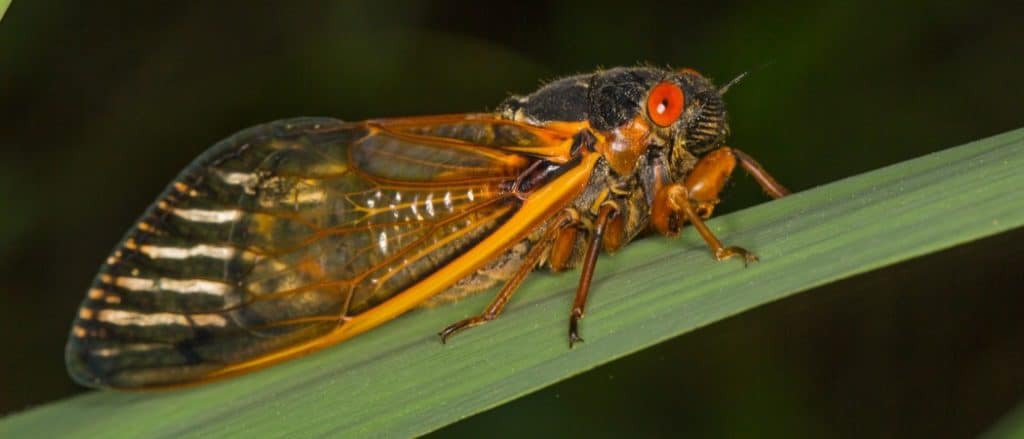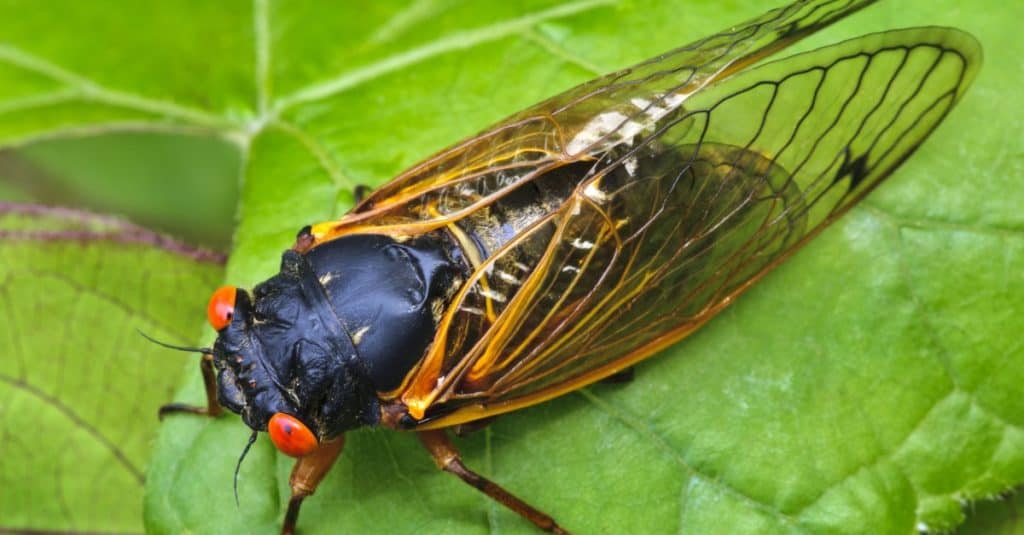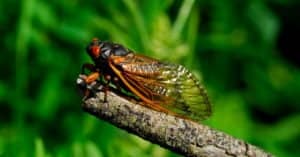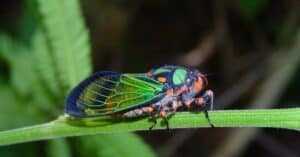Cicadas are unique insects, but we still don’t know a lot about them. Interestingly, humans have been interacting with these insects for a very long time. Some notable artworks, myths, and folklore used these insects to symbolize carefree living, survival, defiance, and immortality.
Let’s take a look at some of the incredible facts about cicadas.
1. Cicadas are not locusts

Cicadas are not as destructive as locusts.
©Georgi Baird/Shutterstock.com
The cicada is often mistaken for a locust, which is not surprising since both insects are slightly similar in appearance. But while locusts are often considered destructive and a crop pest, cicadas are not as destructive. Large swarms of cicadas can cause damage to young trees by laying their eggs on the branches, but bigger trees can generally tolerate the cicadas.
Locusts, on the other hand, are significantly more harmful since they eat plant parts of different varieties. Massive swarms of locusts can wreak havoc on agricultural land, eating everything green in sight and causing famine and economic loss.
2. Not all cicadas are seen worldwide
Knowing that some cicadas take up to seventeen years to emerge is pretty amazing, but when they emerge, they are found in specific places. Cicadas that emerge every summer are found in all parts of the world, whereas periodical cicadas that naturally take longer to emerge are found only in North America.
Witnessing the mass emergence of periodical cicadas is a beautiful phenomenon. The Central United States is home to these periodical cicadas, with some specific areas having more than one species of this rare insect.
3. It takes several years for cicadas to mature into adults

Cicadas have impressive lifespans.
©Elliotte Rusty Harold/Shutterstock.com
Interestingly, cicadas have the longest life cycle of any insect, although, like many other insects, female cicadas lay their eggs in woody plant tissues. When the eggs hatch, the newly hatched nymphs fall to the ground and burrow into tree roots feeding on their sap or juices.
The nymphs are wingless and live underground, although very close to the surface, and they require several years before they reach maturity undergoing five molting stages. Once they reach maturity, they emerge in late May and early June, spending between two to four weeks engaging in a flurry of activities, such as flying, courting, mating, and disturbing people.
The adult females will lay their eggs in trees, which hatch in seven to ten weeks, and the process is repeated. The females are not considered pests, but they can damage tree saplings, especially when laying eggs.
4. Male cicadas can sing as loud as a lawn mower
Male cicadas produce loud noises by contracting the ridged membranes known as tymbals at the base of their abdomens. The sound is a mating ritual rite to attract females to the sexually charged males. It sounds shocking, but the sound produced can be as loud as a lawn mower reaching ninety to one hundred decibels (100 dB).
What is interesting is how this amazing insect amplifies the sound. It is done by the hollow abdomen of male cicadas, which act as a sound box. Another intriguing thing about this sound is that the musical buzzes, ticks, or whines create a rhythm.
5. Cicadas do not bite or sting

Naturally, the cicada neither bites nor stings.
©Mary Terriberry/Shutterstock.com
Ordinarily, you will expect insects like cicadas to bite or sting, but this is not the case. Cicadas only have prickly feet, unlike bees or wasps, which can bite and sting. When their legs come in contact with the skin, it can cause itchiness. Aside from that, the cicada is naturally not a biter or stinger.
6. Some cicadas take a long time to emerge
It’s fascinating how some cicada species take years to emerge. Cicadas have about 3000 species, with some, such as the brood X, taking as long as seventeen years. Magicicada takes thirteen years to emerge, while some emerge every summer.
Scientists have suggested that this cicada species’ long emergence is developed in response to predators like the praying mantis and cicada killer wasps. The theory is based on this predator’s shorter life cycles, ranging between two to five years.
Another hypothesis for this long-term emergence is that cicadas used it to avoid the Ice Age to bypass the cold seasons as species co-emerged and hybridized. They left behind unique species with periods that matched prime numbers that did not hybridize.
7. Cicada emergence is specific
Whenever cicadas emerge, it is one of those rare, beautiful nature moments that people should not miss in their lifetime. Cicada emerging from the soil depends largely on the soil temperature, with the ideal temperature being 1470F.
The right temperature is followed by warm rain, with the first set emerging between late April and early May. Another cue for cicada emergence is when trees have grown leaves, so they have a place to lay their eggs or when the iris flower starts to bloom.
8. Cicadas are large sources of food
Cicadas are prey for a lot of birds and mammals. At every emergence, birds, reptiles, mammals, and amphibians become cicada predators. They benefit from the mass population of this insect with other insects, even killing the newly hatched nymphs and other small mammals foraging for them in their burrow.
Unsurprisingly, these insects serve as a source of delicacies for humans in Asia and Africa who enjoy the taste.
9. Cicadas can regulate their body temperature
Unlike most insects that depend on nature to regulate their temperature, cicadas require no help in this area. Cicadas are excellent regulators of their body temperature. They regulate their temperature through a process known as evaporative cooling.
Cicadas feed excessively on water-rich xylem sap and excrete them through tergum pores. They can also raise their temperature above ambient temperature.
10. Cicadas have a long, rich history with human art and literature
Did you know that cicadas were used in artworks long before scientists decided to study them? It is true! Artists had long found visualization, descriptive, and storytelling abilities in cicadas. In some cultures, the cicada symbolizes survival or defiance against death.
Cicadas were used as motifs during the Shang dynasty and as the name of a character in a Chinese 14th-century romance novel. One of the great philosophers, Aristotle, described cicadas in his book. Even the sound they produced was mentioned in the poem of Hesiod.
The photo featured at the top of this post is © 1979825168/Shutterstock.com
Thank you for reading! Have some feedback for us? Contact the AZ Animals editorial team.






